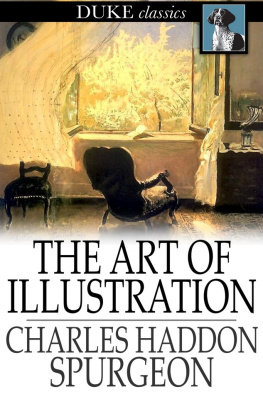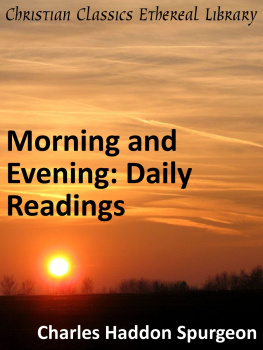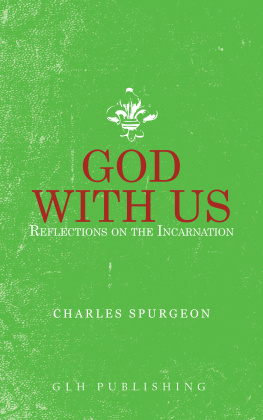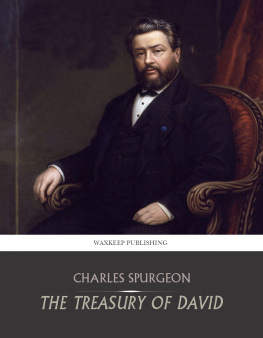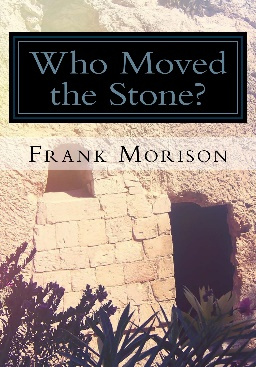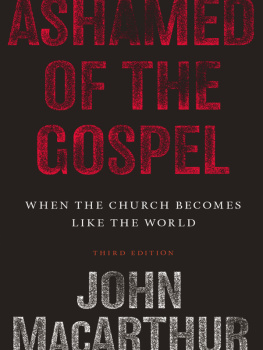Charles Haddon Spurgeon - The Art of Illustration
Here you can read online Charles Haddon Spurgeon - The Art of Illustration full text of the book (entire story) in english for free. Download pdf and epub, get meaning, cover and reviews about this ebook. year: 2013, publisher: Duke Classics, genre: Art. Description of the work, (preface) as well as reviews are available. Best literature library LitArk.com created for fans of good reading and offers a wide selection of genres:
Romance novel
Science fiction
Adventure
Detective
Science
History
Home and family
Prose
Art
Politics
Computer
Non-fiction
Religion
Business
Children
Humor
Choose a favorite category and find really read worthwhile books. Enjoy immersion in the world of imagination, feel the emotions of the characters or learn something new for yourself, make an fascinating discovery.
- Book:The Art of Illustration
- Author:
- Publisher:Duke Classics
- Genre:
- Year:2013
- Rating:4 / 5
- Favourites:Add to favourites
- Your mark:
- 80
- 1
- 2
- 3
- 4
- 5
The Art of Illustration: summary, description and annotation
We offer to read an annotation, description, summary or preface (depends on what the author of the book "The Art of Illustration" wrote himself). If you haven't found the necessary information about the book — write in the comments, we will try to find it.
British pastor and theologian Charles Haddon Spurgeon was one of the most influential religious leaders of his time, and his work continues to inspire millions of Christians today. This collection brings together a series of the most popular and moving homilies that Spurgeon presented at the famed Metropolitan Tabernacle in London.
The Art of Illustration — read online for free the complete book (whole text) full work
Below is the text of the book, divided by pages. System saving the place of the last page read, allows you to conveniently read the book "The Art of Illustration" online for free, without having to search again every time where you left off. Put a bookmark, and you can go to the page where you finished reading at any time.
Font size:
Interval:
Bookmark:

First published in 1894
ISBN 978-1-62013-440-5
Duke Classics
2013 Duke Classics and its licensors. All rights reserved.
While every effort has been used to ensure the accuracy and reliability of the information contained in this edition, Duke Classics does not assume liability or responsibility for any errors or omissions in this book. Duke Classics does not accept responsibility for loss suffered as a result of reliance upon the accuracy or currency of information contained in this book.
The lectures in this volume were originally delivered to the students ofthe Pastors' College, Metropolitan Tabernacle, London, England. It isthe first of his unfinished books to be published, and one to which hehad himself given the title, "The Art of Illustration."
Of the five lectures included in this volume, the first two were revisedduring Mr. Spurgeon's lifetime. Two were partially revised by him beforebeing redelivered to a later company of students than those who hadheard them for the first time.
The remaining lecture was printed substantially as it was taken by thereporter; only such verbal corrections having been made as wereabsolutely necessary to insure accuracy of statement. Mr. Spurgeon hassaid of his lectures to his students: "I am as much at home with myyoung brethren as in the bosom of my family, and therefore speakwithout restraint. I do not offer that which has cost me nothing, for Ihave done my best, and taken abundant pains. Therefore, with clearconscience, I place my work at the service of my brethren, especiallyhoping to have a careful reading from young preachers, whose profitinghas been my principal aim."
W. B. K.
The topic now before us is the use of illustrations in our sermons.Perhaps we shall best subserve our purpose by working out anillustration in the present address; for there is no better way ofteaching the art of pottery than by making a pot. Quaint Thomas Fullersays, "Reasons are the pillars of the fabric of a sermon; butsimilitudes are the windows which give the best lights." The comparisonis happy and suggestive, and we will build up our discourse under itsdirection.
The chief reason for the construction of windows in a house is, asFuller says, to let in light. Parables, similes, and metaphors havethat effect; and hence we use them to illustrate our subject, or, inother words, to "brighten it with light," for that is Dr. Johnson'sliteral rendering of the word illustrate. Often when didactic speechfails to enlighten our hearers we may make them see our meaning byopening a window and letting in the pleasant light of analogy. OurSaviour, who is the light of the world, took care to fill his speechwith similitudes, so that the common people heard him gladly; hisexample stamps with high authority the practice of illuminating heavenlyinstruction with comparisons and similes. To every preacher ofrighteousness as well as to Noah, wisdom gives the command, "A windowshalt thou make in the ark." You may build up laborious definitions andexplanations and yet leave your hearers in the dark as to your meaning;but a thoroughly suitable metaphor will wonderfully clear the sense. Thepictures in an illustrated paper give us a far better idea of thescenery which they represent than could be conveyed to us by the bestdescriptive letterpress; and it is much the same with scripturalteaching: abstract truth comes before us so much more vividly when aconcrete example is given, or the doctrine itself is clothed infigurative language. There should, if possible, be at least one goodmetaphor in the shortest address; as Ezekiel, in his vision of thetemple, saw that even to the little chambers there were windows suitableto their size. If we are faithful to the spirit of the gospel we laborto make things plain: it is our study to be simple and to be understoodby the most illiterate of our hearers; let us, then, set forth many ametaphor and parable before the people. He wrote wisely who said, "Theworld below me is a glass in which I may see the world above. The worksof God are the shepherd's calendar and the plowman's alphabet." Havingnothing to conceal, we have no ambition to be obscure. Lycophrondeclared that he would hang himself upon a tree if he found a person whocould understand his poem entitled "The Prophecy of Cassandra." Happilyno one arose to drive him to such a misuse of timber. We think we couldfind brethren in the ministry who might safely run the same risk inconnection with their sermons. Still have we among us those who are likeHeraclitus, who was called "the Dark Doctor" because his language wasbeyond all comprehension. Certain mystical discourses are so dense thatif light were admitted into them it would be extinguished like a torchin the Grotta del Cane: they are made up of the palpably obscure and theinexplicably involved, and all hope of understanding them may beabandoned. This style of oratory we do not cultivate. We are of the samemind as Joshua Shute, who said: "That sermon has most learning in itthat has most plainness. Hence it is that a great scholar was wont tosay, 'Lord, give me learning enough, that I may preach plain enough.'"
Windows greatly add to the pleasure and agreeableness of a habitation,and so do illustrations make a sermon pleasurable and interesting. Abuilding without windows would be a prison rather than a house, for itwould be quite dark, and no one would care to take it upon lease; and,in the same way, a discourse without a parable is prosy and dull, andinvolves a grievous weariness of the flesh. The preacher in Solomon'sEcclesiastes "sought to find out acceptable words," or, as the Hebrewhas it, "words of delight": surely, figures and comparisons aredelectable to our hearers. Let us not deny them the salt of parable withthe meat of doctrine. Our congregations hear us with pleasure when wegive them a fair measure of imagery: when an anecdote is being told theyrest, take breath, and give play to their imaginations, and thus preparethemselves for the sterner work which lies before them in listening toour profounder expositions. Riding in a third-class carriage some yearsago in the eastern counties, we had been for a long time without a lamp;and when a traveler lighted a candle, it was pleasant to see how alleyes turned that way, and rejoiced in the light: such is frequently theeffect of an apt simile in the midst of a sermon; it lights up the wholematter, and gladdens every heart. Even the little children open theireyes and ears, and a smile brightens up their faces as we tell a story;for they, too, rejoice in the light which streams in through ourwindows. We dare say they often wish that the sermon were allillustrations, even as the boy desired to have a cake made all of plums;but that must not be: there is a happy medium, and we must keep to it bymaking our discourse pleasant hearing, but not a mere pastime. No reasonexists why the preaching of the gospel should be a miserable operationeither to the speaker or to the hearer. Pleasantly profitable let allour sermons be. A house must not have thick walls without openings,neither must a discourse be all made up of solid slabs of doctrinewithout a window of comparison or a lattice of poetry; if so, ourhearers will gradually forsake us, and prefer to stay at home and readtheir favorite authors, whose lively tropes and vivid images afford morepleasure to their minds.
Font size:
Interval:
Bookmark:
Similar books «The Art of Illustration»
Look at similar books to The Art of Illustration. We have selected literature similar in name and meaning in the hope of providing readers with more options to find new, interesting, not yet read works.
Discussion, reviews of the book The Art of Illustration and just readers' own opinions. Leave your comments, write what you think about the work, its meaning or the main characters. Specify what exactly you liked and what you didn't like, and why you think so.

